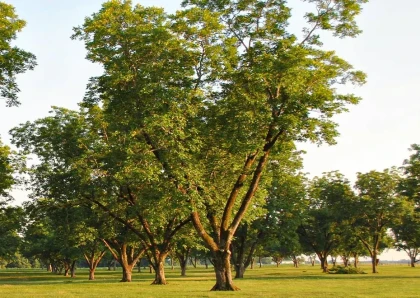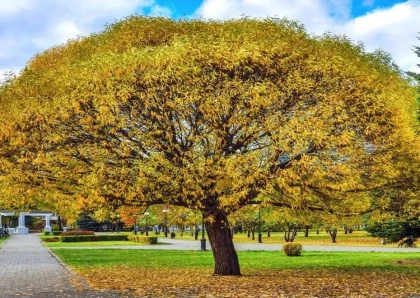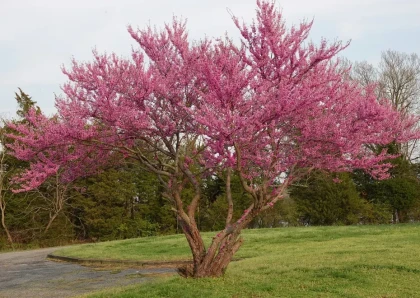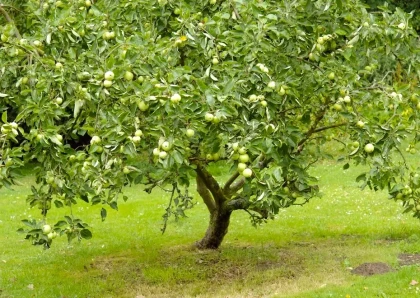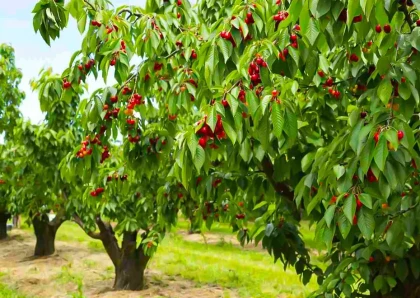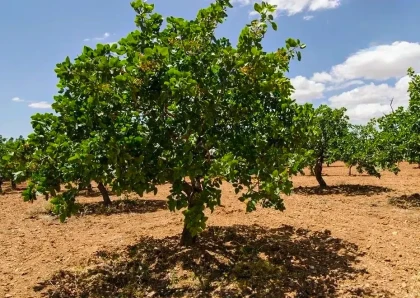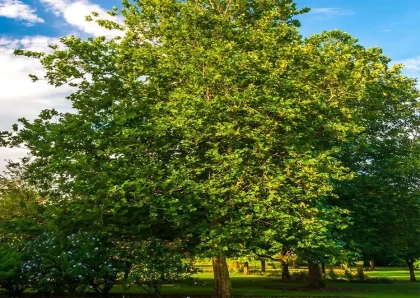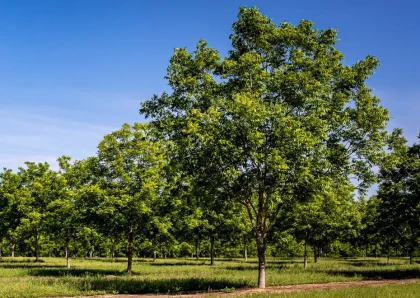
Kwik-Krop Walnut Tree
Overview
History of the Tree
The Kwik-Krop Walnut Tree has a rich history that dates back many decades. Developed by renowned horticulturist Dr. John A. Kellogg in the early 20th century, this walnut tree cultivar was specifically bred to have a shorter growth period and faster nut maturity compared to other walnut varieties. Its introduction revolutionized the walnut industry and made it easier for growers to harvest and enjoy fresh walnuts in a shorter time frame.
Detailed Description of the Tree
The Kwik-Krop Walnut Tree is a deciduous tree that belongs to the Juglans genus. It is characterized by its medium to large size, reaching heights of 40 to 60 feet (12 to 18 meters) and spreading up to 30 to 40 feet (9 to 12 meters) in width. The tree features a broad, spreading canopy with attractive dark green foliage that turns golden-yellow in the fall, creating a stunning display of autumn colors.
The nuts produced by the Kwik-Krop Walnut Tree are medium-sized and have a smooth, light brown shell. The kernel inside is rich and flavorful, making it highly sought after for culinary purposes. The tree begins producing nuts at a relatively young age, typically within 3 to 4 years of planting, allowing for earlier harvests and quicker returns for growers.
Types of This Tree
The Kwik-Krop Walnut Tree belongs to the Juglans genus, which encompasses various walnut species and cultivars. While Kwik-Krop is a distinct cultivar, there may be variations or sports within the species that exhibit slightly different characteristics or traits.
Importance of This Tree
The Kwik-Krop Walnut Tree holds several important qualities:
- Early Nut Production: One of the key advantages of the Kwik-Krop variety is its ability to produce nuts at a relatively young age. This allows growers to enjoy earlier harvests and faster returns on their investment compared to other walnut varieties that take longer to mature.
- Shorter Growth Period: The Kwik-Krop Walnut Tree has a shorter growth period, meaning it reaches maturity and starts producing nuts sooner than many other walnut trees. This characteristic is particularly beneficial for commercial growers who rely on timely harvests for profitability.
- High-Quality Nuts: The nuts produced by the Kwik-Krop Walnut Tree are known for their excellent flavor and quality. The rich, flavorful kernels make them highly desirable for both culinary and snacking purposes, appealing to walnut lovers and chefs alike.
How to Care for This Tree
Proper care is crucial for the health and productivity of the Kwik-Krop Walnut Tree:
- Plant the tree in a location that provides full sunlight and well-drained soil. Walnuts thrive in areas with good air circulation and prefer deep, loamy soil.
- Water the tree regularly, especially during dry periods, to keep the soil consistently moist. Adequate irrigation is essential for optimal growth and nut development.
- Apply a layer of organic mulch around the base of the tree to conserve moisture, suppress weed growth, and regulate soil temperature.
- Prune the tree during the dormant season to remove dead or damaged branches and promote proper airflow and sunlight penetration throughout the canopy.
- Monitor for pests and diseases regularly. Implement appropriate pest management strategies, such as using organic sprays or attracting beneficial insects, to prevent or control common walnut tree pests and diseases.
Benefits of the Tree
The Kwik-Krop Walnut Tree offers several benefits:
- Early Nut Harvest: The early nut production of the Kwik-Krop variety allows growers to enjoy the fruits of their labor sooner, providing an earlier return on investment.
- Delicious Flavor: The kernels of the Kwik-Krop walnuts are prized for their rich, nutty flavor. They can be enjoyed fresh, roasted, or used in a variety of culinary creations.
- High Nutritional Value: Walnuts are known for their nutritional benefits, and the Kwik-Krop variety is no exception. They are a good source of healthy fats, protein, fiber, vitamins, and minerals, contributing to a well-rounded diet.
- Ornamental Value: In addition to its practical benefits, the Kwik-Krop Walnut Tree also adds aesthetic value to landscapes with its broad, spreading canopy and attractive foliage. It can be a focal point in gardens or orchards.
How to Plant This Tree
Follow these steps to successfully plant a Kwik-Krop Walnut Tree:
- Choose a planting location that provides full sunlight and well-drained soil.
- Dig a hole that is wide and deep enough to accommodate the tree's root system.
- Place the tree in the hole, ensuring that the bud union or graft union is above the soil line.
- Backfill the hole with soil, gently firming it around the roots to remove air pockets.
- Water the tree thoroughly after planting and continue to water regularly, especially during the first year, to promote root establishment.
Different Types of Wood Products That Can Be Made From
The wood of the Kwik-Krop Walnut Tree is highly valued for its beauty and durability. It can be used in various woodworking projects, including furniture, cabinetry, flooring, and decorative items. The wood exhibits a rich, warm tone with a distinct grain pattern, making it sought after by craftsmen and artisans.
Cons
While the Kwik-Krop Walnut Tree has numerous advantages, there are a few considerations to keep in mind:
- Pest and Disease Management: Walnut trees, including Kwik-Krop, can be susceptible to various pests and diseases, such as walnut blight, walnut aphids, and walnut husk fly. Regular monitoring, proper sanitation, and implementing appropriate pest management practices are necessary to prevent and control these issues.
- Space Requirements: Kwik-Krop Walnut Trees have a large spreading habit, requiring ample space in the orchard or landscape. Ensure proper spacing between trees to allow for adequate airflow, sunlight penetration, and future growth.
- Pollination Requirements: While Kwik-Krop trees can self-pollinate to some extent, cross-pollination with another compatible walnut variety can improve nut production and overall yields. Planting additional walnut trees nearby, especially those with overlapping bloom periods, can enhance pollination and maximize nut set.
FAQs
Q: How long does it take for Kwik-Krop Walnut Trees to produce nuts?
A: Kwik-Krop Walnut Trees typically start producing nuts within 3 to 4 years of planting, allowing for earlier harvests compared to many other walnut varieties.
Q: Are Kwik-Krop walnuts suitable for baking?
A: Yes, Kwik-Krop walnuts are excellent for baking. Their rich flavor and crunchy texture make them a popular choice for a wide range of baked goods, including cakes, cookies, and breads.
No listings available
Related Products
Questions & Answers
What do you want to know about this product?
Reviews (5)
HarvestMaster3456
A Game-Changer!
The Kwik-Krop Walnut Tree has revolutionized my orchard! The early nut production is a game-changer, and the flavor is exceptional. Highly recommended for walnut enthusiasts!
TreeWhisperer99
A Nut Lover's Dream Come True
If you love walnuts, the Kwik-Krop Walnut Tree is a must-have. Its early nut production and high-quality kernels make it a dream come true for nut enthusiasts. Thrilled with the results!
NuttyProfessor27
Fast and Flavorful
The Kwik-Krop Walnut Tree lives up to its name! Its quick maturity and flavorful nuts are a delight. The tree is easy to care for, and the harvest is rewarding. A top-notch choice!
WalnutWizard123
Impressive Results
As a walnut connoisseur, I'm impressed with the Kwik-Krop Walnut Tree. The nuts are delicious, and the early harvest means less waiting. It's a winner in my orchard!
SquirrelWhisperer51121
Nutty Goodness All Around<
The Kwik-Krop Walnut Tree delivers on its promises. The nuts are packed with flavor, and the tree's performance is outstanding. I'm a happy squirrel with this addition to my forest!




